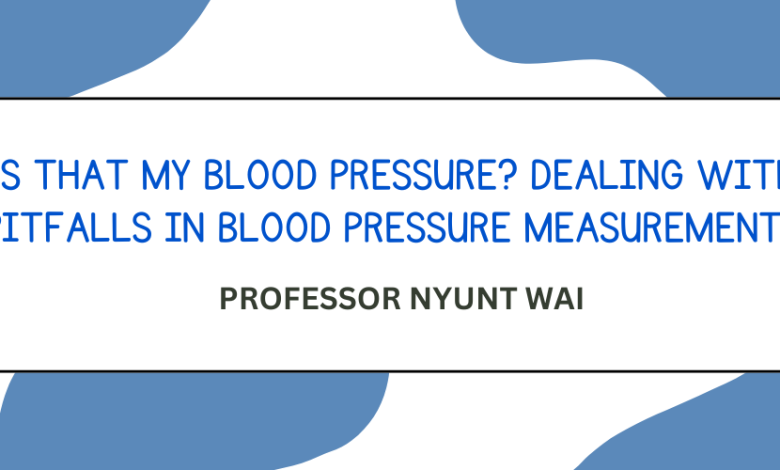IS THAT MY BLOOD PRESSURE? DEALING WITH PITFALLS IN BLOOD PRESSURE MEASUREMENT

Introduction
The accurate and valid measurement of blood pressure (BP) is the bedrock of the management of arterial BP disorders. Despite technological advances, the only practical method available to health care givers for diagnosing or monitoring hypertension remains indirect sphygmomanometry, which is fraught with inherent and potential errors. In the face of the rising global threat of hypertension to public health, how accurately we measure the BP is crucial, and this depends on our knowledge of the factors affecting the BP and the principles and issues of the method used,
This article focuses on three devices commonly used: the mercury (the gold standard) and aneroid devices and the automated digital devices.
A. Before the Measurement
A1.Office setting
BP measurements should be taken in a quiet room set at a comfortable temperature. A cool room (12°C) can raise the BP by 8-15 mm Hg.
A2. Subject (patient) preparation:
Allow subjects to sit and relax in a comfortable setting at least ten minutes before BP measurement. Physical activity and exercise increase blood pressure, but by ten minutes the BP and heart rate return to the pre-exercise values.
Mental arithmetic, anger, emotional excitement, apprehension and resentment can cause acute rise in blood pressure. We do not have control over others’ mental state but we can reassure them and minimize provocations.
Give subjects the opportunity to urinate well before taking the BP because bladder distension increases sympathetic activity and the BP (by 15/10 mmHg).
Ask the subject to refrain from smoking cigarette or drinking coffee an hour before visiting doctor’s office. Reason: A cup of strong coffee acutely increases BP (10 mm Hg at peak) for 90 minutes. Cigarette smoking also has blood pressure raising effect.
A3. Measuring devices
Check if the following are in good working order (no damages or leakage):
(a) The stethoscope (for mercury and aneroid devices)
(b) The sphygmomanometer: The mercury reservoir should be full so that the upper curve of the meniscus is at the zero level before the cuff is inflated. The mercury should rise and fall freely in the column; bouncing or hesitation of the mercury during deflation reflects clogging of the air vent or dirt or air bubbles in the column. For aneroid device, the needle should rest at the zero point before the cuff is inflated and return to that point after the cycle of inflation and deflation. Make sure the device has been regularly calibrated (at least every 6 months).
(c) The inflation system (the bladder encased in the cuff, the bulb and its valve, the tubing) should be free from leakage, cracks and melting due to heat. There should not be any residual air in the bladder.
B. During the measurement
B1.Subject position
The subject must be comfortably seated on the chair (with back rest), the leg sun crossed (if crossed, the B Prises by 2 to 8 mmHg), the feet resting firmly on the floor (or a footstool), and the back straight and supported. Slouching, unsupported back/feet (isometric muscle contraction) increase BP by 6 to 10 mmHg.
The arm should be supported on the table. The midpoint of the upper arm (the brachial artery) must be at the level of the heart (the right atrium) (approximately the 4th intercostal space or mid-sternum). This is to avoid the error due to hydrostatic effects of the blood column in the artery (if the upper arm is below the level of the right atrium, the BP can be artificially high; if above, it will be falsely low).
When the subject is standing, raised arm should be supported at the level of the heart. When lying down, the arm should be at the side of the body, slightly raised from the bed and supported (with a pillow or folded blanket), at the level of the middle of the chest.
Be sure the cuff is placed on a bare arm Wrapping the cuff over clothing is a common error that can add 5 to 10 mmHg to a reading. Rolling up the sleeve that forms a tight tourniquet around the upper arm leads to errors. If the sleeve material is thin but could not be rolled up and the subject is reluctant to remove the clothing for modesty reasons, wrapping the cuff over the thin sleeve would give lesser error.
As BP is affected by environmental, emotional, and physical stimuli, every effort should be made to standardize the conditions of the measurement, keeping extraneous influences to a minimum.
B2. For mercury and aneroid devices:
The bladder inside the cuff should encircle 80% of the arm in adults. If in doubt, use a larger cuff. If the available cuff is too small, this should be noted. The air pressure generated by inflating the small cuff (or the standard cuff on large, obese or muscular arms) may not be fully transmitted to the brachial artery, leading to over estimation of the BP by about 15 mm Hg.
The cuff must be placed so that the midline of the bladder lies over the palpated brachial arterial pulsation. This ensures the air pressure in the bladder is evenly transmitted to the artery. Failing to do so leads to erroneous readings.
The cuff should be wrapped and secured “snugly” around the bare upper arm. Loose application of the cuff causes over estimation of the BP. The lower edge of the cuff should be one inch above the antecubital fossa.
The device should be placed on the flat surface with the mercury column vertical and the upper meniscus of the mercury column should be viewed “at eye level”.
Use the palpatory method (Inflating the cuff rapidly to 70 mm Hg, and increasing by 10 mm Hg increments while palpating the radial pulse) for (i) approximation of the systolic BP (the level at which the pulse disappears during cuff inflation); (ii) avoiding under inflation of the cuff in subjects with an auscultatory gap and over inflation in those with very low BP. Alternatively, you may straightaway do the auscultation, inflating the bladder rapidly and steadily up to 180 mmHg (instead of to a pressure20 to 30 mm Hg above the level previously determined by palpation).
It is crucial to deflate the bladder at the rate of 2 to 3 mm/sec (or 2 to 3 mm per Korotkoff sound or heartbeat, assuming the heart rate of 60 beats per min). Too fast a deflation rate produces a significant underestimation of systolic and overestimation of diastolic BP, while too slow a deflation rate produces arm congestion and a higher diastolic BP.
As the pressure in the bladder falls, note the manometer level at the first appearance of repetitive sounds (Phase I) and at the muffling of these sounds (Phase IV) and when they disappear (Phase V). After the last Korotkoff sound is heard, the cuff should be deflated slowly for at least another 10 mm Hg, to ensure that no further sounds are audible, and then rapidly and completely deflated. Allow the subject to rest for at least 30 seconds if the measurement is to be repeated.
The systolic (Phase I) and diastolic (Phase V) (or Phase IV when the sounds are audible up to 0 mmHg) BPs should be immediately recorded, rounded off(upwards) to the nearest 2 mm Hg, along with the position (sitting, lying) and the side of the arm (left or right).
B3. For the digital device, the arrow marked on the cuff should be along the midline of the bare arm and the monitor should be placed on a flat surface at the same level as the supported upper arm.
B4. The mercury column or the aneroid dial or the digital display should be placed away from the subject’s view so as to prevent anxiety which may be associated with watching these.
C. After the measurement
If you have noted certain pitfalls that could not be avoided during the measurement, you can make a better explanation to the subject regarding the blood pressure results. Even if the BP reading is moderately high, never tell the subject that he/she has hypertension. A situational and transient rise in BP (strenuous physical exercise or mental stress) is not hypertension.
If time allows, educate the subject (e.g. to wear light clothing which facilitates baring of the armsat the next visit). A printed pamphlet might be helpful.
Note: It is advisable to measure the BP of both arms on the first visit, and use the arm with higher pressure on the subsequent visits.
The BP levels surge in the morning and dip at night. Cardiovascular events are more likely to occur in the early morning hours (after 6 am) than during the rest of the day. Patients already diagnosed with hypertension should take readings both early in the morning and at night.
CONCLUSIONS
Awareness of these pitfalls by the operator as well as by the subject (patient) could facilitate more accurate measurement of BP.
EXERCISE:
Comment on the blood measurements in photographs A and B.

REFERENCES
- Badeli H, Assadi F. Strategies to Reduce Pitfalls in Measuring Blood Pressure.Int J Prev Med. 2014 Mar; 5(Suppl 1): S17–S20.
- Pickering TG, Hall JE, Appel LJ, Falkner BE, Graves J, Hill MN, et al. Recommendations for blood pressure measurement in humans and experimental animals: Part 1: Blood pressure measurement in humans: A statement for professionals from the Subcommittee of Professional and Public Education of the American Heart Association Council on High Blood Pressure Research. Hypertension. 2005; 45:142–61.
- Perloff D, Grim C, Flack J, Frohlich ED, HillM, Mc Donald M, Morgenstern BZ. Human blood pressure determination bysphygmomanometry. Circulation 1993;
88:2460-2470. - Nyunt Wai, Khaled MAB, Sikarwar AS. Is having had a cup of coffee a methodological issue in routine sphygmomanometry? British Journal of Medicine & Medical Research (Science Domain), 2015; 6(10):965-977. DOI: 10.9734/BJMMR/2015/15037.
- Ohnmar, Nyunt Wai, Htay Htay, Lay Htar.The acute cardiovascular effects of
coffee drinking in Myanmar Subjects.Myanmar Med. J. 1999; 43:4-7. - Nyunt Wai, Sze Wei Thing, Ting Ngiik Liing, Self-measured bed-time, arising and day blood pressures of normotensive young male and female adults. IeJSME (International Medical University, KL, Malaysia) 2011; 5 (1): 31-33
- Fagius J, Karhuvaara S. Sympathetic activity and blood pressure
increases with bladder distension in humans. Hypertension 1989; 14:511-517 - Virdis A, Giannarelli C, Neves MF, Taddei S, Ghiadoni L. Cigarette smoking and hypertension. Curr Pharm Des. 2010; 16(23):2518-25.
Nyunt Wai, MBBS, MMedSc (Yangon), PhD (London)
Professor & Head (retired), Department of Physiology, University of Medicine 1, Yangon






